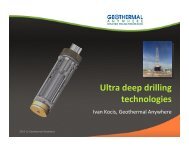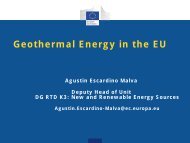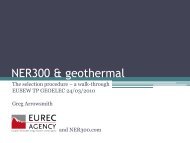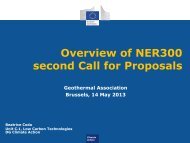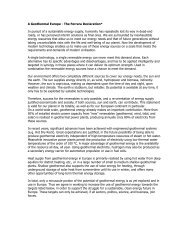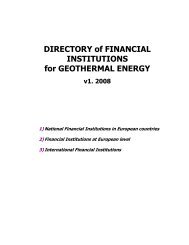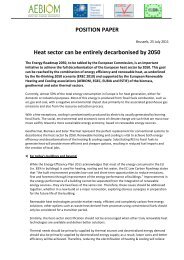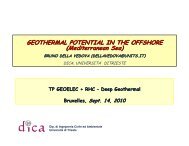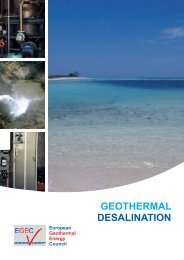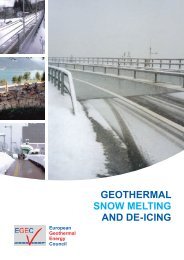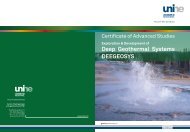Strategic Research and Innovation Agenda for Renewable ... - EGEC
Strategic Research and Innovation Agenda for Renewable ... - EGEC
Strategic Research and Innovation Agenda for Renewable ... - EGEC
You also want an ePaper? Increase the reach of your titles
YUMPU automatically turns print PDFs into web optimized ePapers that Google loves.
<strong>Renewable</strong>Heating & CoolingEuropean Technology Plat<strong>for</strong>mTo give communities the possibility to choose the best energy mix, evaluate new installations<strong>and</strong> adopt the most energy efficient behaviour, appropriate tools <strong>and</strong> equipment must bedeveloped. Given their intrinsic functional complexity, additional research is needed on toolsthat provide a flexible user interface tailored to different stakeholder groups: operators/utilities, user communities, ESCOs, <strong>and</strong> financial institutions. Each group requires a different“view” (focus, detail level) of the common underlying in<strong>for</strong>mation (production <strong>and</strong> consumptionin<strong>for</strong>mation, user profile, social aspects, demographics, economics,business models, etc). Sophisticated data mining <strong>and</strong> simple but effective visualisationof complex processes is a must <strong>for</strong> building smart tools <strong>and</strong> services.The involvement of end user communities can also be stimulated by implementing socialnetwork tools (or extending existing ones) <strong>for</strong> the dissemination of in<strong>for</strong>mation about bestpractices <strong>and</strong> results obtained by virtuous behaviour. An efficient RHC system is uselessif not properly used.7.2 Materials scienceThe advanced materials sector is one of the traditional strengths of European industry.Moreover, materials research is at the core of sustainable technologies <strong>for</strong> <strong>and</strong> solutions toour thermal energy needs. <strong>Research</strong> <strong>and</strong> development of new materials as well as the underst<strong>and</strong>ing<strong>and</strong> use of their properties is crucial to enable scientists <strong>and</strong> engineers to enhanceenergy systems <strong>and</strong> to realize the full potential of renewable heating <strong>and</strong> cooling technologies.Materials play a pivotal role in the renewable energy technologies explored in this report.Materials science is ubiquitous <strong>and</strong> it is extremely difficult - even detrimental - to break it upby specific application. The results of material research generate opportunities <strong>for</strong> complementarity<strong>and</strong> synergies between different applications both within <strong>and</strong> beyond the energysector. One example is the development of novel thermal insulation materials to store thermalenergy, which could also be applied to reduce the losses of district heating <strong>and</strong> cooling. Bothapplications have far reaching impact enhancing the potential of RES.In 2011, the European Commission presented a new working paper dedicated to “MaterialsRoadmap Enabling Low Carbon Energy Technologies” 76 . Regrettably, materials research<strong>for</strong> heating <strong>and</strong> cooling technologies has largely been overlooked in the EC Roadmap.The added value of novel functional <strong>and</strong> structural materials <strong>for</strong> heating <strong>and</strong> cooling is oftenunderestimated in terms of required resources <strong>and</strong> lead times necessary to ensure differentiatinghigh added value results. In the medium to long term, it is essential that sufficientmeans are dedicated to materials R&D <strong>and</strong> demonstration.The present report by the RHC-Plat<strong>for</strong>m addresses a large number of strategic researchpriorities relevant to materials research. While designed to address the specific needs ofeach RHC technology, several priorities are common to more than one technology. In addition,a broad range of activities proposed <strong>for</strong> one application can profitably be shared with otherapplications either within the energy sector or in other economic sectors (e.g. the work onphase change materials <strong>for</strong> thermal energy storage is potentially also of great benefit to theconstruction industry).Leveraging these complementarities <strong>and</strong> synergies is of critical importance <strong>for</strong> theimplementation of the RHC-Plat<strong>for</strong>m’s <strong>Strategic</strong> <strong>Research</strong> <strong>and</strong> <strong>Innovation</strong> <strong>Agenda</strong>.Economies of scale <strong>and</strong> scope can be realised <strong>and</strong> cross-technology knowledge canbe pooled at European level to accelerate the development <strong>and</strong> integration of innovativematerials into low carbon energy technologies. The following table shows the strategic researchpriorities that are relevant to materials science:76European Commission(2011b).75



